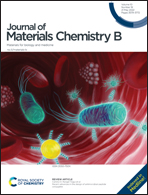Rational design of dual-functional surfaces on polypropylene with antifouling and antibacterial performances via a micropatterning strategy†
Abstract
The hydrophobicity and inertness of the polypropylene (PP) material surface usually lead to serious biofouling and bacterial infections, which hamper its potential application as a biomedical polymer. Many strategies have been developed to improve its antifouling or antibacterial properties, yet designing a surface to achieve both antifouling and antibacterial performances simultaneously remains a challenge. Herein, we construct a dual-function micropatterned PP surface with antifouling and antibacterial properties through plasma activation, photomask technology and ultraviolet light-induced graft polymerization. Based on the antifouling agent poly(2-methacryloyloxyethyl phosphate choline) (PMPC) and the antibacterial agent quaternized poly(N,N-dimethylamino)ethyl methacrylate (QPDMAEMA), two different micropatterning structures have been successfully prepared: PP-PMPC-QPDMAEMA in which QPDMAEMA is the micropattern and PMPC is the coating polymer, and PP-QPDMAEMA-PMPC in which PMPC is the micropattern and QPDMAEMA is the coating polymer. The composition, elemental distribution and surface morphology of PP-PMPC-QPDMAEMA and PP-QPDMAEMA-PMPC have been thoroughly characterized by Fourier transform infrared (FT-IR) spectroscopy, X-ray photoelectron spectroscopy (XPS) and scanning electron microscopy (SEM), respectively. Compared with pristine PP, the two types of micropatterned PP films exhibit good surface hydrophilicity as characterized by water contact angle measurements. The results of anti-protein adsorption, platelet adhesion and antibacterial evaluation showed that PP-PMPC-QPDMAEMA and PP-QPDMAEMA-PMPC had good anti-protein adsorption properties, especially for lysozyme (Lyz). They can effectively prevent platelet adhesion, and the anti-platelet adhesion performance of PP-QPDMAEMA-PMPC is slightly better than that of the PP-PMPC-QPDMAEMA sample. The sterilization rate of S. aureus and E. coli is as high as 95% for the two types of micropatterned PP films. Due to the rational design of micropatterns on the PP surface, the two classes of dual-functional PP materials realize both the resistance of protein and platelet adhesion, and the killing of bacteria at the same time. We anticipate that this work could provide a design strategy for the construction of multifunctional biomedical polymer materials.



 Please wait while we load your content...
Please wait while we load your content...